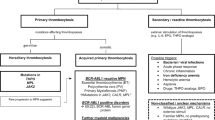Abstract
Purpose
Chemotherapy-induced thrombocytopenia (CIT) can cause delay or reduction in subsequent courses of chemotherapy. Here, we report on a series of 20 patients who had protracted CIT and were treated with romiplostim, a thrombopoietin receptor agonist.
Patients and methods
We performed a retrospective review of the use of romiplostim for dose-limiting CIT at Memorial Sloan–Kettering Cancer Center from 2010–2012. Romiplostim was initiated at 1–2 mcg/kg weekly, with dose escalation by 1 mcg/kg per week until recovery of platelets (≥100 × 109/L). If patients resumed chemotherapy, weekly romiplostim was continued.
Results
Romiplostim improved platelet counts in all 20 patients. In 19 of 20 patients, platelet counts of ≥100 × 109/L were achieved. The mean dose of romiplostim to achieve adequate platelet recovery was 2.9 mcg/kg (range 1.0–5.1). Sixteen patients achieved platelet recovery by 2 weeks. Fifteen patients resumed cytotoxic chemotherapy with continued romiplostim support and 14 tolerated at least two subsequent cycles of chemotherapy, on schedule, without recurrence of dose-limiting CIT. Sepsis prevented continued chemotherapy in one patient. No resistance to romiplostim was observed. Three deep vein thromboses (DVT) were observed; one of which was a recurrent DVT in a patient who had previously experienced a DVT and was off anticoagulation. Three DVTs within 20 patients is within the anticipated thrombosis rates of patients with active cancer on chemotherapy.
Conclusion
Romiplostim resulted in improvement in platelet counts, allowing resumption of chemotherapy without recurrence of dose-limiting CIT. No treatment-related toxicity was observed, but this would need to be confirmed in a larger, prospective trial. Our series differs from prior studies in that we selected only those patients who had already demonstrated persistent thrombocytopenia, and we continued weekly romiplostim during chemotherapy. Romiplostim may be a safe and effective treatment for CIT.


Similar content being viewed by others
References
Elting LS, Rubenstein EB, Martin CG et al (2001) Incidence, cost, and outcomes of bleeding and chemotherapy dose modification among solid tumor patients with chemotherapy-induced thrombocytopenia. J Clin Oncol 19:1137–1146
Kuter DJ (2010) Biology and chemistry of thrombopoietic agents. Semin Hematol 47:243–248
Kuter DJ, Begley CG (2002) Recombinant human thrombopoietin: basic biology and evaluation of clinical studies. Blood 100:3457–3469
Li J, Yang C, Xia Y et al (2001) Thrombocytopenia caused by the development of antibodies to thrombopoietin. Blood 98:3241–3248
Vadhan-Raj S (2000) Clinical experience with recombinant human thrombopoietin in chemotherapy-induced thrombocytopenia. Semin Hematol 37:28–34
Broudy VC, Lin NL (2004) AMG531 stimulates megakaryopoiesis in vitro by binding to Mpl. Cytokine 25:52–60
Kuter DJ (2010) Biology and chemistry of thrombopoietic agents. Semin Hematol 47:243–248
Liebman HA, Pullarkat V (2011) Diagnosis and management of immune thrombocytopenia in the era of thrombopoietin mimetics. Hematol Am Soc Hematol Educ Program 2011:384–390
Fanale M, Stiff P, Noonan K et al (2009) Safety of romiplostim for treatment of severe chemotherapy induced thrombocytopenia (CIT) in patients with lymphoma receiving multi-cycle chemotherapy: results from an open-label dose- and schedule-finding study (abstract). EJC Suppl 7:563–563
Natale R, Charu V, Schutte W et al (2009) Safety of romiplostim for treatment of chemotherapy-induced thrombocytopenia (CIT) in patients with advanced non-small cell lung cancer (NSCLC) (abstract). EJC Suppl 7:574–574
Vadhan-Raj S, Hagemeister F, Fayad LE et al (2010) Randomized, double-blind, placebo-controlled, dose and schedule-finding study of AMG 531 In chemotherapy-induced thrombocytopenia (CIT): results of a phase I/II study (abstract). Blood 116:656–657
Winer ES, Safran H, Karaszewska B, et al.: Safety and efficacy of eltrombopag (epag) versus placebo (pbo) for the treatment (tx) of chemotherapy-induced thrombocytopenia (CIT) in patients with solid tumors receiving gemcitabine (gem)-based chemotherapy (ctx): A phase I study. J Clin Oncol (suppl) 30, 2012
Gardner K, Mathe S, Sahu S (2012) Leukaemic transformation with romiplostim. Br J Haematol 158:153
Bennett CL, Silver SM, Djulbegovic B et al (2008) Venous thromboembolism and mortality associated with recombinant erythropoietin and darbepoetin administration for the treatment of cancer-associated anemia. JAMA 299:914–924
Rodgers GM 3rd, Becker PS, Blinder M et al (2012) Cancer- and chemotherapy-induced anemia. J Natl Compr Canc Netw 10:628–653
Tonia T, Mettler A, Robert N et al (2012) Erythropoietin or darbepoetin for patients with cancer. Cochrane database syst rev 12:CD003407
Heit JA (2005) Venous thromboembolism: disease burden, outcomes and risk factors. J Thromb Haemost : JTH 3:1611–1617
Hillen HF (2000) Thrombosis in cancer patients. Ann Oncol : Off J Eur Soc Med Oncol/ESMO 11(Suppl 3):273–276
Prandoni P (2005) How I treat venous thromboembolism in patients with cancer. Blood 106:4027–4033
Prandoni P, Falanga A, Piccioli A (2005) Cancer and venous thromboembolism. Lancet Oncol 6:401–410
Kuter DJ, Mufti GJ, Bain BJ et al (2009) Evaluation of bone marrow reticulin formation in chronic immune thrombocytopenia patients treated with romiplostim. Blood 114:3748–3756
Author information
Authors and Affiliations
Corresponding author
Rights and permissions
About this article
Cite this article
Parameswaran, R., Lunning, M., Mantha, S. et al. Romiplostim for management of chemotherapy-induced thrombocytopenia. Support Care Cancer 22, 1217–1222 (2014). https://doi.org/10.1007/s00520-013-2074-2
Received:
Accepted:
Published:
Issue Date:
DOI: https://doi.org/10.1007/s00520-013-2074-2




